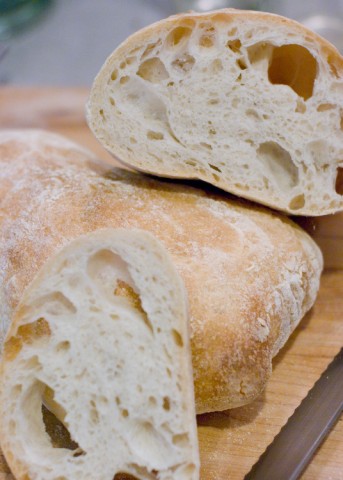I’ve been playing a lot with rustic bread, and specifically with Ciabatta, recently. And I’ve had a couple of thoughts. They’re probably obvious if you know anything about artisan baking, but I’m kind of figuring it out as I go along. I don’t in any sense think that I’ve got it right yet. In fact, I’m dissatasfied with my recent attempts in almost every way. But I have figured a couple of things out. Maybe:
First, you need more water than you think you do. What ordinarily counts as a wet dough is a dry ciabatta, and won’t produce the level of openness that you expect in a good ciabatta crumb. A good baguette is about 65% hydration. I tried the ciabatta at 80% hydration, and it wasn’t enough. This most recent one is at about 83% hydration, which seems to be much more promising. Perhaps in the future 85%? 90%?
Second, you need to knead more than you think you do, and you need to do it with a stand mixer and a dough hook. At 83% hydration, dough looks a little bit like thick soup at first. And it takes a bit more than ten minutes at medium high on my mixer before it looks like bread dough. And even then, as soon as you stop the mixer, it goes back to being way too mushy to touch.
Which brings me to my next thought: even with all your kneading, you need to stretch and fold. After its turn in the mixer, I dump my dough on the counter, and give it a good stretch and fold, repeating two or three times. Then, after a half hour, I do it again. This helps develop the gluten, and helps your dough retain its shape.
Fourth, flour is your friend. At such high hydrations, a little bit of flour on the bread board to keep your dough from sticking isn’t going to make anything too dense. So be liberal with the flour, covering your work surface, and sprinkling on the dough itself before you cover it. You’ll be much happier in the end when your cling wrap comes away from the dough without taking giant chunks with it.
Fifth, as a corollary: a good dough scraper is your friend. Stainless steel and relatively sharp, preferably. It is much MUCH easier to fold wet dough when it isn’t sticking to your hands.
And finally: shaping? Who needs shaping? After the dough’s initial rise, degas it a little bit, sunder it atwain, and sort of stretch and fold it until it looks approximately like a ciabatta should. It takes some delicacy not to squish the dough such that it loses all of its beautiful big bubbles, but mostly, it’s just a matter of getting it off the board without it falling apart.
The results so far:
And a recipe:
450g Organic Unbleached All-Purpose White Flour
370g Water
2 tsp yeast
1.5 tsp salt
The Night Before:
Combine your yeast with 200g of water and 200g of flour. Mix well, cover, and leave on the counter overnight.
Baking Day:
To your sponge, add the rest of the flour, 100g of water, and your salt. Place in the stand mixer and knead for 5-7 minutes, until you have a bread dough.
Allow that dough to rest for 15 minutes. Then add the rest of your water, run the mixer slowly to blend the water in, then have it knead on medium for 10-12 minutes, until your dough goes from looking like soup to looking like bread.
While that is going on, spread some flour on a clean counter. Then, when the kneading is done, pour (yes pour!) your dough onto the floured surface. Fold a couple of times, sprinkle with flour, cover in plastic wrap, and leave for 30 minutes. After 30 minutes, fold a few more times, sprinkle with flour, and put the plastic wrap back in place.
Allow the dough to rise for about 2 hours on the counter. Then degas the dough just a bit, and using a dough scraper, cut it into two equally sized pieces. fold each piece in half, and elongate until it looks like a ciabatta, then cover and allow to proof for 50 minutes or so.
While the dough is proofing, place an empty pan at the bottom of your oven, and a pizza stone (or overturned cookie sheet) in the middle, and heat as high as your oven will go (usually 510F). In the last eight minutes of your dough’s proof, pour about 2 cups of boiling water into the pan on the bottom to create steam.
When your dough is done proofing, transfer it to a floured pizza peal or to the back of yet another cookie sheet, and slide both loaves onto your pizza stone. Pour another cup of boiling water into the pan at the bottom of your oven, close the door, and allow to cook for about five minutes. Then turn your oven down to 450, and allow to cook for another ten minutes. At the end of the ten minutes, turn the ciabattas around, and cook for yet another ten minutes. Then, when they are a golden brown, remove them from the oven, transferring them onto a rack to cool.
Wait at least two hours, until the bread is fully cooled, to cut into it.
Enjoy!
